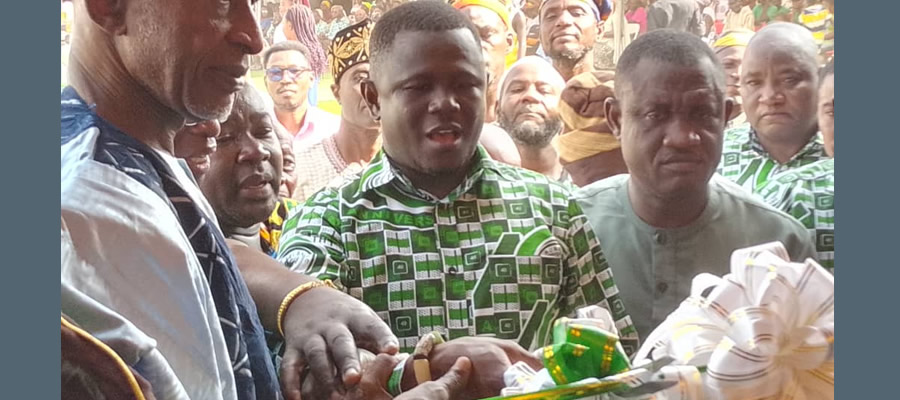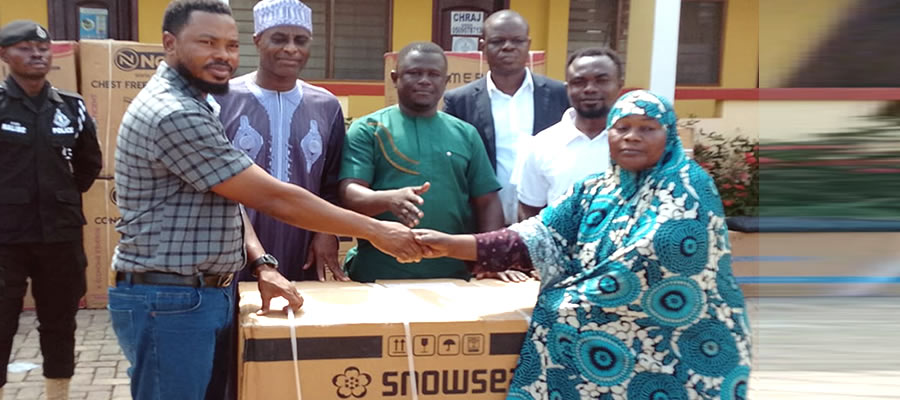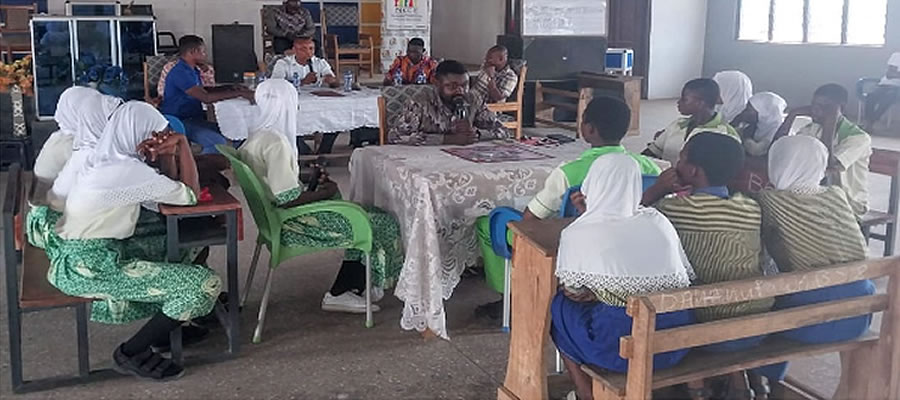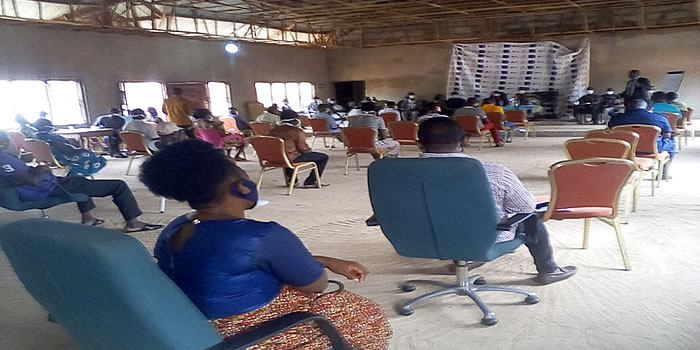

Introduction
Governance refers to that process of decision making and the process by which these decisions are implemented. The concept is applied in many context as such corporate governance, international governance, national governance and local governance. The major characteristics of good governance include: participation, consensus building, transparency, responsiveness, effectiveness and efficiency, equity and inclusiveness, reduction in corruption and voice and accountability of minority groups.
The development process of the district is underpinned on the various institutional set-ups which include traditional governance structures, the private sector, state institutions, non-governmental organizations and community/faith based organizations.
Under the Local Government Act, 2016 (Act 936), the District Assembly is the highest political administrative and planning authority at the District level and responsible for the overall governance and development of the whole District. Under the Act, the Assembly has deliberative, legislative and executive functions.
The Executive Committee, under the Local Governance Act 2016 (Act 936), exercises the executive and co-ordinating functions of the District Assembly. Its functions include:
· Co-coordinating plans and programmes of the Sub-Committees and submitting these as comprehensive plans of action to the District Assembly.
· Implementing resolutions of the District Assembly;
· Overseeing the administration of the District in collaboration with the office of the District Chief Executive;
· Recommending to the District Assembly, the economic, social, spatial and human settlement policies relating to the development of the district;
· Initiating and co-ordinating the process of planning, programming, budgeting and implementation; and
· Monitoring and evaluating all policies, programmes and projects in the district.
Composition of the District Assembly
The District Assembly is made up of the following:
i. The District Chief Executive
ii. 18 Assembly members, made up of 12 elected by universal adult suffrage and 6 other members appointed by Government in line with the Local Governance Act 936, 2016, which requires the Government to appoint 30% of the elected Assembly members in consultation with interest groups.
iii. The Members of Parliament in the District.
The District Chief Executive, who represents the Central Government in the District, chairs the Executive Committee which is responsible for the execution of administrative and executive functions of the District Assembly.
The Executive Committee of the Assembly has the following statutory sub-committees. These include:
- Finance and Administration Sub-committee
- Works Sub-committee
- Social Services Sub-committee
- Development Planning Sub-committee
- Justice and Security Sub-committee
Every Sub-Committee is responsible for collating and deliberating on issues relevant to it and shall submit its recommendations to the Executive Committee of the Assembly. Actions taken are submitted /forwarded to the General Assembly for ratification, approval and implementation. The District Planning Co-ordinating Unit (DPCU) serves as technical backstoping of the District Assembly and is composed of key units and departmental heads and chaired by the District Coordinating Director. Currently, the membership of the 11 member DPCU in the District are the DCD, DPO, DBA, DE, DDH, DDE, DDA, Community Dev. Officer, and a member of the District Assembly. The district lacks the departments of Physical Planning hence depends on Atebubu-Amantin District for such services.
Under Act, 936, decentralized departments of the Assembly are presented in the table below. However, the commencement of section 38 and 161 of the Act, and the coming into force of LI 1961, 18th December, 2009, the departments in the first schedule of the Local Government Act, 1993, Act 462are established as Departments of the District Assemblies under the Local Government Service Act, 2003, Act 656. Departments ceasing to exist and the new departments established are presented in table 1.11 below.
Table 15: Decentralized Departments
Source: LI 1961, Act 656
The existing organizational structure of the Pru District is shown in Figure 10 below
Figure 1.14: Existing District Organogram
Sub-district Structures of the Assembly
Below the District Assembly are the Sub-district Structures established under Legislative Instruments 1589 (LI 1589) in response to the demand for popular participation in promoting decentralization and good governance.
The Assembly is subdivided into two (2) Area Councils, and one (1) Town Council:
· Prang Town Council
· Abease Area Council
· Adjaraja/Beposo Area Council
Despite their relevance, the operations of these sub-district structures are virtually ineffective owing to financial, logistical, office accommodation and human resources capacity challenges. The relevant staff required to manage the operations of the councils are non-existent. The Abease Area Council was trained in various capacity programmes in procurement, stock management, openness, transparency and social accountability, participatory Monitoring and Evaluation and assisted to prepare development plans covering the period 2010 – 2013 and further assisted with GH¢15,000.00 each to implement projects identified in the plan by Community Based Rural Development Projects.
The remaining sub-structures also need to be trained and assisted to identify their needs and assisted to prepare a development plans.
Key Development Issues
1. Inadequate capacity of sub-structures
2. Inadequate resourcing of sub-structures
3. Lack of full complement of all departments/units
4. Inadequate capacity of Assembly Members
5. Inadequate office accommodation for Decentralized Departments
6. Inadequate financial and technical logistics for monitoring and evaluation data management
7. Inadequate qualified personnel in some departments.
Traditional Authority
The District has two Traditional Authorities which includes Prang and Abease paramountcies. These institutions together with their sub chiefs work in harmony to ensure that their paramountcies remain peaceful and have their share of the District and National cakes. The cordial relationship between the traditional authorities and the Assembly would be harnessed for the development of the district. This is especially so in the area of community mobilization, project and programme identification, implementation, monitoring and evaluation development projects and pogrammes.
Traditional authority plays a very important role in the local government system of the District and can therefore be regarded as an integral part of the decentralization process. In the rural areas particularly, they command the respect of large numbers of their people. Allegiance of the people to traditional authority appears stronger, than to formal political authorities. Traditional authorities therefore have a crucial role to play in facilitating government policies and mobilizing their people for development. Another key role of traditional Authority is the issue of support for land administration reform .With a large migrant farmer population in the District, the issue of security of land tenure and protection of the vulnerable and excluded becomes very crucial.
Participation, Consultation and Accountability
Participation has been defined as the process of equitable and active involvement of all stakeholders (individuals, beneficiary communities of a project, donors etc) in the formulation of development policies and strategies and in the analysis, planning, implementation, monitoring and evaluation of development activities be it political, physical, cultural, socio-economic which have a positive effects on their lives.
Participation and consultation is one of the core mandates of the decentralization concept in order to give power to the grass root through empowerment and decision making. This is made possible through the conduct of elections at the local levels through the sub-district structures. Planning has also been decentralized with the authorization of planning at the various levels especially community action planning among others. Participation in the district has the potential of project sustainability.
Accountability is a way of holding authorities responsible for actions taking in the course of delivering their services. As part of this commitment, the Pru West district holds the obligation to at every level communicate to all stakeholders usage of funds and other resources.
Key Development Issues
1. Inadequate resources of the Assembly
2. Low level of awareness
3. Political polarization
Citizenry Participation in Community Development/Decision Making
Citizen’s participation in the district varies with respects to the issue in question. There are a number of factors including benefits to be gained (immediate or future) from the issue under discussions, the availability of appropriate mechanism that allows community members to participate in issues that concern them and their political and religious affiliations. Also of importance is the level of publicity and understanding of the subject. Leadership accountability mechanism also plays a great role to participation in community development. It is however noted that there is a lot of indiscipline and poor citizenry attitude to communal labour accounting for lot of filth in public place and along major drains causing disaffection in the district. These include polythene bags, open defecation, indiscriminate disposal of refuse and waste water. The DA would have to do lot of public education to change people?s behavior towards sanitation and also enforce its by-laws for compliance.
Citizens Participation in Elections
Trend of Participation in general elections over the past four elections are as follows: in 2012, 75.84% and 66.33 in 2016. The target of 100% turnout has not been achieved yet; The Electoral Commission and National Commission on Civic Education must therefore intensify their education to sensitize the public to exercise their franchise since it forms part of their civic responsibilities. In general men turn to be more active than women as it is evidenced in the last district level elections where there were only 1 females out of 28 elected assembly members
VOTER TURN OUT IN PRU WEST DISTRICT
Role of Non-Governmental/Civil Society Organizations
The role of Non-governmental and civil society organizations in the development of the District cannot be overemphasis. The level of participation by these stakeholders clearly shows that there is good collaboration, partnership and information flow between the Assembly and the Stakeholders. To ensure true ownership and sustainability in the District development agenda it is necessary to create the enabling environment for stakeholders and interested groups to effectively contribute to the development process. The Assembly must therefore institute channels for consultation with key stakeholders at the District, Area and community levels.
These may take the form of public fora, information dissemination, Town Council meetings and mass Public Education with the support of the Information Services Department and the National Commission for Civic Education.
SECURITY
Introduction
Data from the District Police Headquarters reveals that there has been an increase in the incidence of crime over the past years. The most prominent among crimes reported to the police station include assault, stealing, highway robbery, acts tending or causing unlawful harm. The increase in crime rates especially armed robbery on the highways is partly due to the inadequate staff of the district police force. The absence of a police check points, inadequate vehicles and the lack of mobile communication equipment make the mobilization of men for operational duties very difficult.
There is therefore the need to strengthen the District police force through increased staff strength, the construction of police barracks and the provision of adequate logistical support to arrest the emerging crime situation in the district. Also, adequate streetlight must be provided in public places in the district.
The Police Service
Internal security and enforcement of law and order in the District is the sole responsibility of the Ghana Police service. However, in the discharge of their duty they collaborate with District Security Committee headed by the DCE, Traditional Authorities and other security agencies, Bureau of National Investigations.
The District has three police stations with total staff strength of 59. With a population of 71,367 (2017 estimate), the police citizen ratio is 1: 2,190 compared to the national figures of 1:761. This is a clear indication of police concentration in the urban areas within the district. The Police Administration of Ghana should therefore make efforts for proper decentralization of the Police to close the gap at the District level. This analysis is base on the existence of one police command in the district.
Key Development Issues
1. Inadequate personnel
2. Lack of vehicle for patrols
3. Inadequate telecommunication network
4. Poor road network in parts of the district
Date Created : 7/12/2023 12:00:00 AM










 facebook
facebook
 twitter
twitter
 Youtube
Youtube
 +233 593 831 280
+233 593 831 280 0800 430 430
0800 430 430 GPS: GE-231-4383
GPS: GE-231-4383 info@ghanadistricts.com
info@ghanadistricts.com Box GP1044, Accra, Ghana
Box GP1044, Accra, Ghana